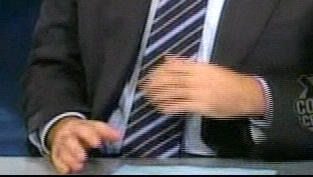Hello all -
I have spent quite a lot of time ripping my movies and converting them to XviD files here at work. One thing I am noticing is that most of my final avi files have some artifacting occurring around moving objects. I set a two hour movie to be 700 MB in final file size. I have come to the conclusion that this is too low, given that XviD files of TV shows I download seem to average about 8 MB per minute of video. So that is one thing I can do to improve my video quality in outputted files.
HOWEVER, it seems as though *movies* I download are set to the same specs (700 MB for a two hour film) and yet they look perfect. Any idea how the folks encoding those files are getting away with this?
Thanks -
Brian Mc
+ Reply to Thread
Results 1 to 14 of 14
-
-
NTSC DVDs. Just stuff I have bought over the years that I'd like to have here at work for when things are slow.
-
You don't give many details about what you're doing (what software, frame size, Xvid settings, etc) but here's some general stuff:
Most Xvid movies you download don't have the full 720x480 frame size. The smaller the frame the less bitrate you need. At the very least, they'll be converted to 1:1 pixel aspect ratio resulting in a 640x480 frame size. Usually smaller like 512x384, 480x360, etc.
Wide screen movies are often anamorphic on the DVD -- ie, they're encoded at 720x480 then reduced to 720x360 by the DVD player for display on a standard definition TV (the top and bottom are padded with 60 lines of black). These are usually reduced to 640x360 or less when converted to Xvid. A 2.25 picture aspec ratio movie might be 640x288 or less.
Most movie DVDs are encoded progressively at 23.976 frames per second and the DVD player performs 3:2 pulldown to create the 59.94 fields per second required to display the picture on a standard definition TV. These should be encoded as progressive 23.976 frames per second with Xvid.
Many TV shows are full 29.97 frames per second interlaced (at least in part). In theory Xvid supports interlaced encoding but you may not be able to find a player that will deinterlace on playback for display on a computer monitor, and set-top Divx/DVD players usually don't handle interlaced Xvid AVI files properly. So you'll most likely want to deinterlace when converting to Xvid. Otherwise you'll get artifacts around moving objects. This sounds like it may be the problem you're having.
When I'm making Xvid files I usually don't care about the exact file size or bitrate. So I use Xvid in single pass Target Quantizer mode which is twice as fast as 2-pass VBR. I usually set the Quantizer at 2 (almost indistinguishable from the source) but that will probably give larger sizes than you want. Try using 3 or more instead.
If you want a fixed file size use 2-pass VBR rather than single pass CBR. That will get you higher quality but will take twice as long to render.
Post a sample of your artifacting and I/we might be able to tell you what's going wrong. Open your file with VirtualDubMod, navigate to a problematic frame, the select Video -> Snapshot Source Frame to save. -
I'm sorry for the lack of details. I am using AutoGK for all of this, and I just let their default settings handle everything, except I changed the audio conversion to CBR MP3 160, and I set it to output an 800 MB file.
I'm wondering if maybe the DVDs I have are in fact 29.97 fps and interlaced. The reason why is because the movies I have ripped and encoded are all actually movies (no tv show episodes) and they have the artifacting around the moving objects that you mentioned. Is it possible that I need to deinterlace these movies? Is there a way to do that in AutoGK? If not, how do you do it (software, etc)?
thanks -
Brian mc -
any chance hardware has something to do with it? It's the weirdest thing....my home machine outputs files that just don't look as good as my work machine does. Specs-wise, the machines are pretty similar. I don't know why this would be the case.
p.s. I guess my video is not interlaced afterall because I have not seen artifacting of that type. -
Hardware generally doesn't make a difference in quality. Installed codecs and other settings will make a difference though.Originally Posted by briansmccabe
Does your problem look more like this crop:

That's an extreme case of not enough bitrate. -
mine don't look anywhere near that bad, but that's getting a little closer to the problem, yeah.
I think I am just going to reencode a few at a higher rate and do a side-by-side comparison. -
Yes, I encoded that at a 200 kbps to make sure it looked very bad!Originally Posted by briansmccabe
I usually find that you need around 1500 kbps VBR to look really good at 640x480, 23.976 fps.Originally Posted by briansmccabe
You'll probably find that those 2 hour movies in 800 MB use very low bitrate audio too. -
The larger frame size won't make much difference in image quality (it's only 12.5 percent in one dimension) but it will take more bitrate. There are special cases where you might consider it though. If you plan on viewing with a set-top Divx/DVD player you may find that it prefers one over the other (don't assume it's 720 simply because that's DVD resolution!). I usually prefer 640 because the video out from my computer works better with that than 720.Originally Posted by briansmccabe
-
that makes sense, and in fact is quite relevant since ultimately my goal is to have all of my DVDs backed up to XviD files for PCHT playback (when I'm in the mood for the 5.1 mix, I'll get off my lazy ass and fetch the disc). I have a machine designated for that purpose but am in between homes at the moment. Thanks for all your help, I set up one of my movies to re-encode at a higher bitrate before leaving work, so tomorrow I will look at them and see if there's much difference.
-
well, I finished re-encoding several movies and doing a side-by-side comparison of them and I was definitely not allowing sufficient bitrates for the video. I decided that I was going to start allowing 8 MB per minute of video, and thus far the results have been a huge improvement. I have some other questions that are unrelated to this particular thread so I will search and if needed start a new thread. Thanks for all your help, you were very helpful!
Similar Threads
-
When you use a PC tuner to HDMI TV input, what causes artifacting?
By MarcMiller in forum Media Center PC / MediaCentersReplies: 0Last Post: 28th Aug 2011, 20:27 -
Conversion from MKV to AVI/MP4 Artifacting
By SakuyaFM in forum Video ConversionReplies: 4Last Post: 14th Sep 2010, 20:41 -
Toshiba DVR610 tracking and video artifacting problems
By ministry88 in forum DVD & Blu-ray RecordersReplies: 14Last Post: 29th Dec 2008, 10:46 -
Xvid to DVD conversion
By Meriks in forum Authoring (DVD)Replies: 5Last Post: 5th Apr 2008, 10:43 -
Help with conversion to Xvid
By zovx in forum DVD RippingReplies: 2Last Post: 6th Feb 2008, 15:32







 Quote
Quote